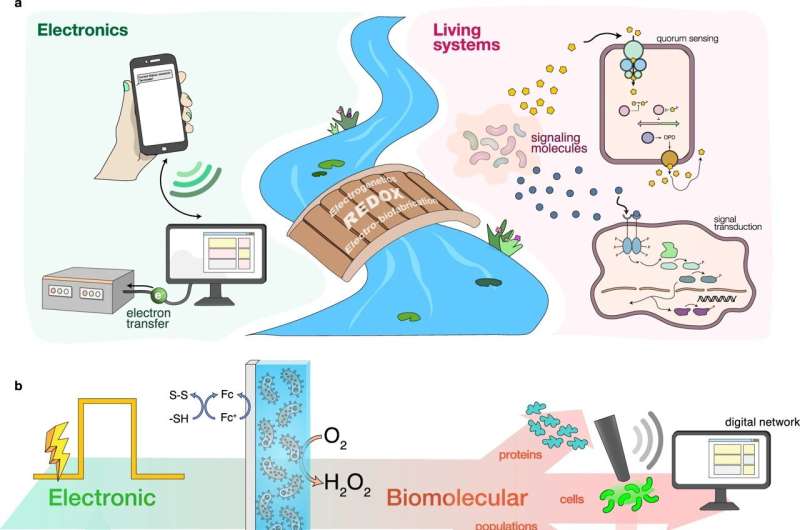This article has been reviewed according to Science X's editorial process and policies. Editors have highlighted the following attributes while ensuring the content's credibility:
fact-checked
trusted source
proofread
Researchers demonstrate control of living cells with electronics

E. coli bacteria and an electronic device might seem to have little in common, but in a recent experiment, University of Maryland researchers linked them into the first closed-loop system able to communicate across the technological–biological divide.
A team from the Robert E. Fischell Institute for Biomedical Devices and the Institute of Bioscience and Biotechnology Research (IBBR) used chemical reactions and genetic engineering to demonstrate how electronic signals can control the biological processes of cells in real time in a paper recently published in Nature Communications.
The research led by bioengineering Professor and Fischell Institute Director William E. Bentley and IBBR Research Professor and Fischell Institute Fellow Gregory F. Payne could be the first step toward developing translatable "smart" health care devices, such as drug-delivery systems for diabetics or real-time trackers of disease progression in cancer patients. (E. coli was chosen because it is an easy-to-propagate microorganism frequently used in experiments.)
The two researchers have been working jointly to advance bioelectronics for years. They say that while devices such as defibrillators and electrocardiograms, which work with electrical signals from the heart, mark great advancements in bioelectronics, there remains a gap in simple devices that access molecular information for health metrics and disease treatment—a gap that their recent progress may begin to address.
"A longstanding impediment to commercialized bioelectronics technology is the ability to successfully establish a seamless connection between biological systems and electronic devices," Bentley said. "As with so many complex relationships, the core of the solution requires good communication—the successful exchange of information."
In conventional electronics, a flow of electrons through wiring and circuitry carries information, while electromagnetic waves do the work in wireless communications.
"In biology, there aren't free electrons moving through your body," said Sally Wang Ph.D. '23, a postdoctoral researcher and co-lead author on this paper with Chen-Yu Chen Ph.D. '23, a fellow researcher in Bentley's lab. "So what do biological systems do to move those electrons? They transfer electrons using redox reactions."
Cells make redox (or reduction-oxidation) molecules, which can transport electrons from one place to another using redox chemical reactions, causing the gain and loss of electrons in cells. This electron transfer results in changes to oxidation levels in cells and is central to important biological processes like photosynthesis and respiration.
Nearly six years ago, Bentley and Payne demonstrated that redox reactions can bridge the gap between biological and electronic systems; they have since worked to engineer and manipulate biological redox networks for bioelectronic information transfer at multiple levels, including proteins, individual cells and groups of cells. This multifaceted and interwoven connection between systems is what the team has coined the "Internet of Life."
Building on this research, Wang and Chen demonstrated a closed-loop system where a cell's biological activity can not only be monitored in real-time using electronic signals, but its genetic systems can also be electronically controlled. The latter function is referred to as "electrogenetics," an approach that the UMD team introduced and that has since been adopted by several groups worldwide.
Using the gene editing tool CRISPR, the team engineered E. coli bacterial cells to include proteins and antibodies from other organisms such as jellyfish and Pseudomonas bacteria to enable E. coli to respond in a specific way to electricity: When they receive electrons, they project fluorescence as optical signals that can be recorded and interpreted by a machine in real time. The machine can then assess whether it needs to supply more current in order to sustain the transfer of electrons between systems, demonstrating a cycle.
The engineered cells can accept electrons from electrodes as well as from cells via redox reactions, making them in effect "bilingual."
"This opens doors for building completely new ways to connect information and data-rich technologies to biology," said Bentley. "There are myriad opportunities that could emerge from electrogenetics."
In addition to health care innovations—for instance, a self-regulated device connected to the body that monitors a disease and precisely administers drugs—the technology has potential applications in agriculture and environmental conservation as well. A "smart" farmland monitor, for example, could telemetrically provide information about how to optimize the microorganism content in soil, suggesting how much pesticide and herbicide to use and when.
More information: Sally Wang et al, Redox-enabled electronic interrogation and feedback control of hierarchical and networked biological systems, Nature Communications (2023). DOI: 10.1038/s41467-023-44223-w
Provided by University of Maryland




















